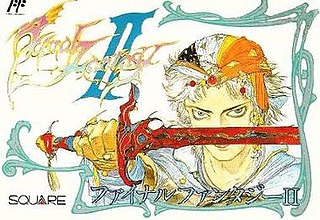
Final Fantasy II is a fantasy role-playing video game developed and published by Square in 1988 for the Family Computer as the second installment of the Final Fantasy series. The game has received numerous enhanced remakes for the WonderSwan Color, the PlayStation, the Game Boy Advance, the PlayStation Portable, iOS, Android and Windows. As neither this game nor Final Fantasy III were initially released outside Japan, Final Fantasy IV was originally released in North America as Final Fantasy II, so as not to confuse players. Following enhanced versions for iOS and Android in 2010 and 2012 respectively, the game was re-released again as part of the 2021 Final Fantasy Pixel Remaster series.

Final Fantasy IV, titled Final Fantasy II in its initial North American release, is a role-playing video game developed and published by Square for the Super Nintendo Entertainment System. Released in 1991, it is the fourth main installment of the Final Fantasy series. The game's story follows Cecil, a dark knight, as he tries to prevent the sorcerer Golbez from seizing powerful crystals and destroying the world. He is joined on this quest by a frequently changing group of allies. Final Fantasy IV introduced innovations that became staples of the Final Fantasy series and role-playing games in general. Its "Active Time Battle" system was used in five subsequent Final Fantasy games, and unlike prior games in the series, IV gave each character their own unchangeable character class — although at a few points in the story, a dark knight will choose the path of a paladin, or a summoner will evolve to a new tier of spellcasting.
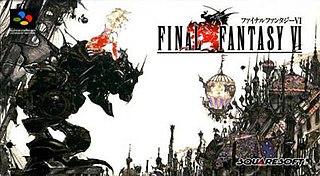
Final Fantasy VI, also known as Final Fantasy III from its initial North American release, is a 1994 role-playing video game developed and published by Square for the Super Nintendo Entertainment System. It is the sixth main entry in the Final Fantasy series, the final to feature 2D sprite based graphics, and the first to be directed by someone other than series creator Hironobu Sakaguchi; the role was instead filled by Yoshinori Kitase and Hiroyuki Ito. Long-time collaborator Yoshitaka Amano returned as character designer and concept artist, while composer Nobuo Uematsu returned to compose the game's score, which has been released on several soundtrack albums.

Final Fantasy VII is a 1997 role-playing video game developed by Square for the PlayStation console and the seventh main installment in the Final Fantasy series. Square published the game in Japan, and it was released in other regions by Sony Computer Entertainment, becoming the first game in the main series to have a PAL release. The game's story follows Cloud Strife, a mercenary who joins an eco-terrorist organization to stop a world-controlling megacorporation from using the planet's life essence as an energy source. Events send Cloud and his allies in pursuit of Sephiroth, a superhuman who seeks to wound the planet and harness its healing power to be reborn as a god. During their journey, Cloud bonds with his party members, including Aerith Gainsborough, who holds the secret to saving their world.

Final Fantasy V is a fantasy role-playing video game developed and published by Square in 1992. It is the fifth main installment of the Final Fantasy series. The game first appeared only in Japan on Nintendo's Super Famicom. It has been ported with minor differences to Sony's PlayStation and Nintendo's Game Boy Advance. An original video animation produced in 1994 called Final Fantasy: Legend of the Crystals serves as a sequel to the events depicted in the game. It was released for the PlayStation Network on April 6, 2011, in Japan. An enhanced port of the game, with new high-resolution graphics and a touch-based interface, was released for iPhone and iPad on March 28, 2013, for Android on September 25 the same year and for Windows on September 24, 2015. A more enhanced re-release of the game as part of the Final Fantasy Pixel Remaster series, was released on November 10, 2021 for Android, iOS, and Windows, and for Nintendo Switch and PlayStation 4 on April 19, 2023.

Final Fantasy III is a role-playing video game developed and published by Square for the Family Computer. The third installment in the Final Fantasy series, it is the first numbered Final Fantasy game to feature the job-change system. The story revolves around four orphaned youths drawn to a crystal of light. The crystal grants them some of its power, and instructs them to go forth and restore balance to the world. Not knowing what to make of the crystal's pronouncements, but nonetheless recognizing the importance of its words, the four inform their adoptive families of their mission and set out to explore and bring back balance to the world.
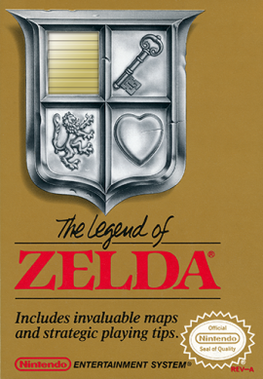
The Legend of Zelda, originally released in Japan as The Hyrule Fantasy: Zelda no Densetsu, is an action-adventure game developed and published by Nintendo. The first game of The Legend of Zelda series, it is set in the fantasy land of Hyrule and centers on an elf-like boy named Link, who aims to collect the eight fragments of the Triforce of Wisdom in order to rescue Princess Zelda from Ganon. The player controls Link from a top-down perspective and navigates throughout the overworld and dungeons, collecting weapons, defeating enemies and uncovering secrets along the way.
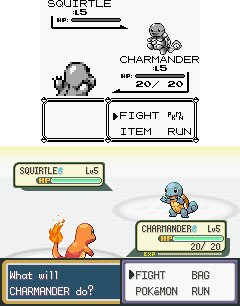
A video game remake is a video game closely adapted from an earlier title, usually for the purpose of modernizing a game with updated graphics for newer hardware and gameplay for contemporary audiences. Typically, a remake of such game software shares essentially the same title, fundamental gameplay concepts, and core story elements of the original game, although some aspects of the original game may have been changed for the remake.

Bahamut Lagoon is a 1996 tactical role-playing game developed and published by Square for the Super Famicom.

Before Crisis: Final Fantasy VII is an action role-playing video game developed by Square Enix and originally released for the FOMA mobile service on September 24, 2004. It was later released for SoftBank Mobile and EZweb in 2007. Before Crisis is a prequel to the 1997 video game Final Fantasy VII and forms part of the Compilation of Final Fantasy VII, a metaseries expanding on and continuing the story established in Final Fantasy VII. It takes place six years prior to the events of Final Fantasy VII and focuses on the adventures of the Turks, a group of covert operatives working for the Shinra Electric Power Company, and their fights against both rebel group AVALANCHE and their corrupt employers.
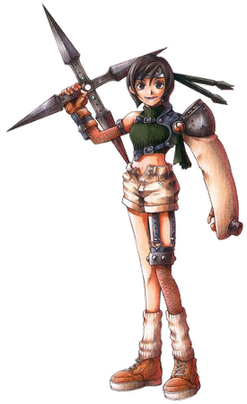
Yuffie Kisaragi is a character from Square Enix's Final Fantasy series. She is designed by Tetsuya Nomura, and was first introduced in the 1997 role-playing video game Final Fantasy VII as a young female ninja princess and thief. She is an optional party member, and can be recruited through a sidequest. Yuffie reappears in the Compilation of Final Fantasy VII series, which expands on her background and shows her after the events of the original game.

King's Knight is a scrolling shooter video game developed and published by Square for the Nintendo Entertainment System and MSX. The game was released in Japan on September 18, 1986 and in North America in 1989. It was later re-released for the Wii's Virtual Console in Japan on November 27, 2007 and in North America on March 24, 2008. This would be followed by a release on the Virtual Console in Japan on February 4, 2015, for 3DS and July 6, 2016, for Wii U.

Bio Miracle Bokutte Upa is a Konami video game that was first released for a Japan-exclusive market in 1988 for the Family Computer Disk System. It was later released as a cartridge in 1993 for the Family Computer itself.
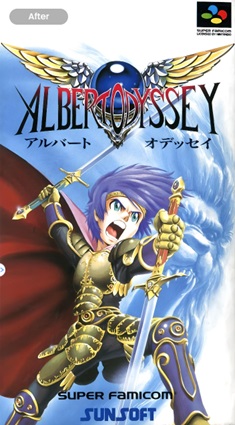
Albert Odyssey is a tactical role-playing video game developed and published by Sunsoft and released for the Super Nintendo Entertainment System in Japan in March 1993. The game features strategy-based combat in addition to traditional role-playing game elements in two-dimensional environments. It is the first game in the Albert Odyssey series, and was followed by two sequels, Albert Odyssey 2: Jashin no Taidou in 1994, and Albert Odyssey: Legend of Eldean in 1996. On June 12, 1996, Albert Odyssey was made available as a full game download on the Satellaview add-on as BS Albert Odyssey, and the original Albert Odyssey was re-released for Satellaview in March 1998.

Metal Slader Glory is an adventure game developed and published by HAL Laboratory for the Famicom in 1991. The game is set in 2062 after humans have colonized the Moon and established several space stations. Earth-based mechanic Tadashi and his girlfriend discover a mech from a war eight years past with an ominous message stored in its memory suggesting Earth is in danger. Tadashi decides to venture to nearby space colonies along with Elina and his younger sister Azusa to investigate the origins of the mech. As Tadashi, the player speaks with other characters and picks dialogue and action commands to advance the narrative.
Dragon Quest is a series of role-playing video games that originated in 1986 with the release of the first game in the series. Although the games are not related in terms of story, many aspects of the gameplay are consistent throughout the series. Each game in the series add new elements to the gameplay, such as longer quests, character classes, or different ways of story-telling.
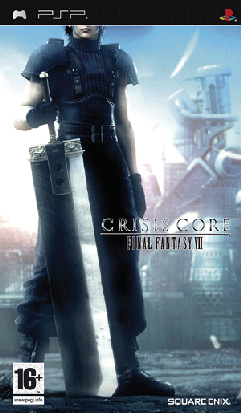
Crisis Core: Final Fantasy VII is an action role-playing game developed and published by Square Enix for the PlayStation Portable. The game was first released in 2007, and serves as a prequel to the 1997 video game Final Fantasy VII. It is part of the metaseries Compilation of Final Fantasy VII, which includes other products related to the original game.

Final Fantasy is a fantasy role-playing video game developed and published by Square in 1987. It is the first game in Square's Final Fantasy series, created by Hironobu Sakaguchi. Originally released for the NES, Final Fantasy was remade for several video game consoles and is frequently packaged with Final Fantasy II in video game collections. The first Final Fantasy story follows four youths called the Warriors of Light, who each carry one of their world's four elemental crystals which have been darkened by the four Elemental Fiends. Together, they quest to defeat these evil forces, restore light to the crystals, and save their world.

Final Fantasy VII Remake is an action role-playing game by Square Enix and released for PlayStation 4 in April 2020. An enhanced version, Final Fantasy VII Remake Intergrade, was released for PlayStation 5 and Windows in 2021.

Final Fantasy VII G-Bike was a free-to-play video game for Android and iOS platforms. Available between October 2014 and December 2015, the title was a racing game with role-playing elements. Based on Square Enix's role-playing game Final Fantasy VII, the player controlled the protagonist of that game, Cloud Strife. While riding on a motorcycle, Cloud battled enemies with melee weapons and magic with help from other Final Fantasy VII characters. Players could modify Cloud's weapons, clothing and motorcycle, and perform powerful attacks known as limit breaks.




















